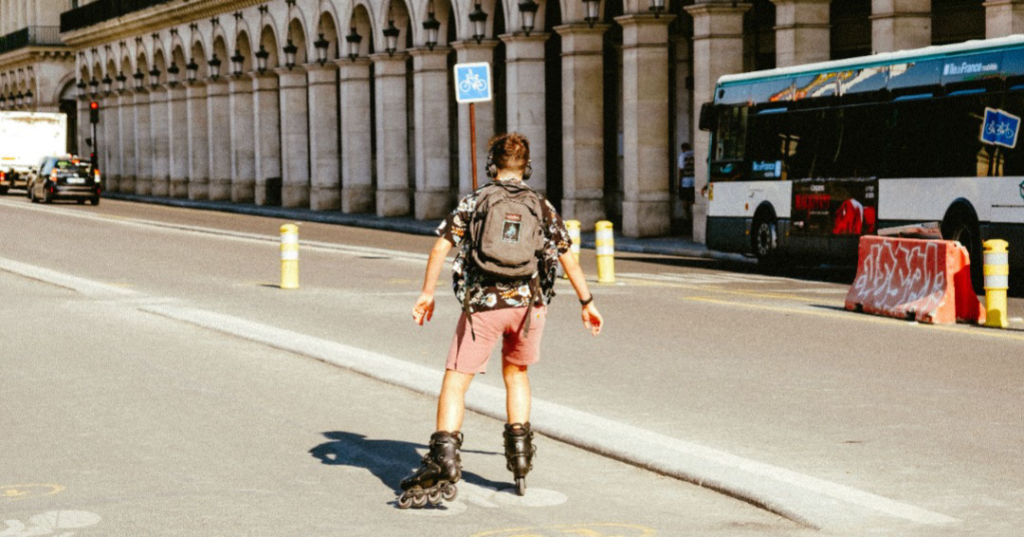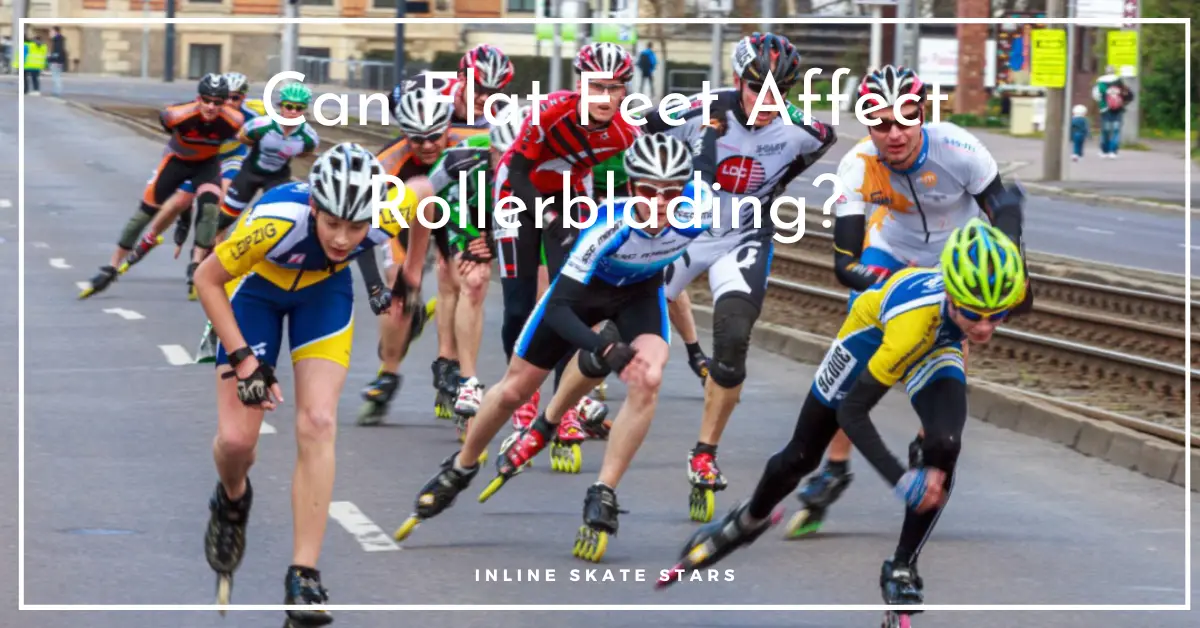Can flat feet affect rollerblading? Not all arches are the same. While some are very high others are low or completely flat. Also, some people are born with flat feet while others develop it later in life.
Aging, heredity, injuries, obesity, and arthritis are some of the primary causes of flat feet. Flat feet are ineffective at shock absorption, exerting excessive stress on the feet, ankles, knees, hips, and up the spine.
I got you if you’re wondering whether you can rollerblade with flat feet. That’s why I’ve put together this guide. So, let’s get to it!
Can Flat Feet Affect Rollerblading?
Can flat feet affect rollerblading? Flat feet don’t affect rollerblading. You should be able to rollerblade comfortably despite having flat feet when you use the recommened rollerblades for flat feet.
However, if your flat feet are causing discomfort when you skate, you may need to use appropriate rollerblades and use the recommended skating posture.
Also, fasten your skates for a better fit and ankle support, rollerblade on smooth surfaces, and warm up before rollerblading. In rare cases, you may need to see a podiatrist.
How to Rollerblade With Flat Feet

Flat feet are a common condition that affects three out of every ten people.
One in 10 people with flat feet has symptoms, while the other nine do not. This means that 90% of people affected by flat feet lead a normal life and can rollerblade normally.
However, 10% of flat feet victims can experience discomfort when rollerblading and need to make some accommodations.
Let’s examine several techniques to help you have a better rollerblading (also known as inline skating) experience, even if you have flat feet.
The routines discussed here will benefit everyone, even those with no symptoms of flat feet.
1. Use Appropriate Roller Skate
A poor choice of inline skates can make skating unbearable, especially if you have flat feet.
Therefore, making the right investment at the purchase stage is critical to avoid later regret.
The right inline skate for flat feet should improve stability, support your ankles, and absorb shock waves.
The following are some factors to consider while purchasing a skate for flat feet:
- Firm material. Skates made of stiff plastic are firm and provide ankle stability. Squeeze the plastic during purchase to get a good idea of its firmness.
- A high profile. Skates with a high profile that covers the ankles are suitable for flat feet. This is because they reinforce and stabilize ankles.
- Choose skates with a comfortable interior. Choose skates with a comfortable liner for your feet. You can also fit custom footbeds inside liners for added comfort.
- Pick skates with short, thick wheels. Short wheels lower your center of gravity, whereas wide wheels provide a large surface area in contact with the ground. This combination improves your skating stability.
- Soft urethane wheels. Soft wheels absorb vibrations and improve traction. A durometer is the standard tool for measuring the hardness of skate wheels. The firmer the wheel, the higher the durometer rating. The current range of inline wheels is between 75A and 93A. You should pick wheels on the lower end of the range because they have good shock damping properties.
- Choose long-framed skates. A longer frame has more surface area and, as a result, more front-to-back stability. It also allows space for more wheels which also boosts your balance.
- Fitting skates. Choose a skate that fits snugly. Most skate companies use the conventional shoe sizing system, making it easier to pick the correct skate size. If your skates are loose, you can wear moderately thick socks to fill in the extra space. Thick socks also provide cushioning.
- Break in your new skates before skating. New skates can be tense initially before they adjust to your feet, and skating in them can be a nightmare. Wear your new skates for a few moments, take them off to relax your feet, and repeat until they conform to your feet. Be patient because this will take some time. Also, always wear safety gear – a helmet, knee and elbow pads, and wrist guards – to protect your joints because they are more vulnerable.
Here are some of the best Rollerblades for people with flat feet!
- K2 Sports Men’s Exo Inline Skates
- Rollerblade Zetrablade Women’s Adult Fitness Inline Skate
- Rollerblade RB Cruiser Unisex Adult Fitness Inline Skate
- Bladerunner by Rollerblade Advantage Pro XT Women’s Adult Fitness Inline Skate
- Roller Derby Aerio Women’s Inline Skates
2. Use Recommended Skating Posture
Using proper posture keeps your body weight balanced on the balls of your feet. A well-balanced weight distribution provides an even distribution of pressure on your joints and is, therefore, easy on flat feet.
To attain the correct posture:
- Keep your gaze forward and your head up
- Position your skates shoulder-width apart
- Slightly bend your knees to squat
Always maintain a relaxed stance. A stiff body absorbs shocks poorly and causes muscles to fatigue quickly.
3. Fasten Your Skate for a Better Fit and Ankle Support
Skating with loose skates puts strain on your ankles. Flat feet can worsen this condition because they do not absorb shock efficiently.
A well-fastened skate will support the ankles and relieve stress on flat feet. Fastening the laces and buckling firmly around your ankles provides much-needed reinforcement.
Be careful not to overtighten the skates. Go for a snug, comfortable fit that allows unrestricted blood circulation while providing ankle support.
4. Skate on Smooth Surfaces
Flat feet are ineffective in shock absorption. It is, therefore, critical to reduce your exposure to shock waves.
Avoid rough surfaces as they have higher vibrations when skating.
Vibration can alter tendons, muscles, bones, and joints, impact the neurological system and have long-term effects on your health. This can worsen flat feet and compromise overall body stability.
Skating on flat, smooth surfaces, like skating rinks, limits your exposure to the damaging effects of vibrations.
Also, remember to glide gently and take it easy on rollerblading tricks like spins and jumps because they put extra strain on the ankles.
It is, however, safe to perform softer tricks such as backward skating. Also, rollerblade moderately. Skate only as much as your flat feet will allow.
5. Warm-up Before Rollerblading
Warming up gets your body ready for aerobic action. A warm-up cranks your cardiovascular system by increasing blood flow to your muscles and elevating your body temperature.
It also relaxes your muscles and tones them for rigorous exercise. Try stretching exercises before putting on your skates to loosen your muscles and reduce the risk of injury.
6. See a Podiatrist
If you still experience difficulties even after applying these tips, it’s time to see a doctor.
You should also see a doctor if flat feet undermine the performance of your everyday tasks like walking.
A podiatrist will diagnose you and give you the correct prescription. The podiatrist may recommend orthotics — custom-made inserts to support feet curve.
A doctor could also prescribe exercises like heel stretches, tennis/golf ball rolls, arch lifts, calf raises, stair arch raises, towel curls, and toe raises to help correct flat feet.
You can also use the following orthotic insoles for flat feet. Feel free to check them out on Amazon.
- Superfeet Unisex-Adult Insoles
- Spenco Total Support Max Shoe Insoles
- Powerstep Pinnacle Pink Arch Support Insoles
Can Flat Feet Affect Rollerblading? | Conclusion
Rollerblading is an excellent sport. But, some people with flat feet may find it uncomfortable. However, you should not let this discourage you from enjoying rollerblading.
Fitting inline skates, proper skating posture, fastening your skates, rollerblading on smooth ground, and warming up before rollerblading will help ease discomfort and allow you to enjoy your favorite sport.



